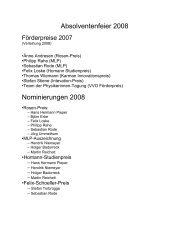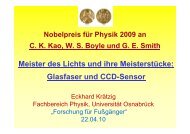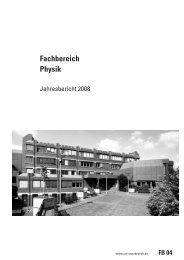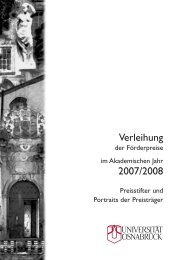Universität Osnabrück, Graduiertenkolleg Mikrostruktur oxidischer
Universität Osnabrück, Graduiertenkolleg Mikrostruktur oxidischer
Universität Osnabrück, Graduiertenkolleg Mikrostruktur oxidischer
Erfolgreiche ePaper selbst erstellen
Machen Sie aus Ihren PDF Publikationen ein blätterbares Flipbook mit unserer einzigartigen Google optimierten e-Paper Software.
12 UNIVERSITÄT OSNABRÜCK, FACHBEREICH PHYSIK<br />
energy surfaces determined for LiNbO3 look very similar to those of LiTaO3. As a consequence, the difference<br />
in the transition temperatures in these compound can be ascribed to the differences in their energetics at the zone<br />
boundary. Similar results were obtained later by Yu and Park [10].<br />
More recently, Parlinski et al. [11] derived the dispersion relations for both paraelectric and ferroelectric<br />
phases of LiNbO3 using the direct method [12]. From their study, the phonon frequencies are also available,<br />
whereas the eigenvectors were not calculated.<br />
Ergebnisse<br />
Within the framework of density functional theory (DFT) [13], we optimized the equilibrium groundstate<br />
structure of paraelectric and ferroelectric structures of LiNbO3 using the full-potential linearized augmented<br />
plane wave method with the addition of the local orbital basis<br />
functions [14] as implemented in the WIEN97 code [15]. Besides the calculation of the theoretical lattice parameters,<br />
the structure optimization included also the relaxation of the atomic positions according to the symmetry<br />
constraint imposed by the crystal symmetry. The computational setup used in our calculation as well as the<br />
values of the lattice parameters and the relaxed atomic positions were reported in Ref. [16].<br />
The ferroelectric instability in LiNbO3 was investigated with respect to its fully optimized paraelectric<br />
structure. The total-energy profile calculated for atomic displacements described by A2u symmetry showed that<br />
this phase is energetically unstable (with respect to the symmetry-lowering atomic displacements). This result<br />
agrees with those of Inbar and Cohen, but it was obtained without any a priori assumption regarding the experimental<br />
pattern of the ferroelectric transition in this material.<br />
Using the frozen-phonon method [17], we proceeded with the analysis of the zone-center lattice dynamics<br />
in the ferroelectric phase of LiNbO3. The Γ-TO phonons are split by symmetry into four A1, five A2 and nine<br />
E modes. The A1 and E modes are both Raman and infrared active, whereas the A2 modes are silent. The<br />
motivation of our study resides in a controversial attribution of the displacement patterns corresponding to<br />
different modes. As was emphasized in Ref. [18,19], the physical properties of LiNbO3 depend significantly on<br />
the presence of both intrinsic and extrinsic defects. Particularly, the Raman spectroscopy is very sensitive to the<br />
stoichiometry of LiNbO3 crystals, and this could result in the appearance of new lines or in the shift of some<br />
frequencies. Thus, only limited experimental information regarding the atomic displacements was available by<br />
means of isotope effect [20] or from the comparison of Raman spectra recorded for LiNbO3 and LiTaO3 [21].<br />
The measured Raman frequencies [18,20,22] for congruent and nearly stoichiometric samples together<br />
with those calculated [11,23] for perfectly ordered LiNbO3 crystal are presented in Table I.<br />
Table I. Calculated and measured frequencies (cm -1 ) of four A1-TO modes in LiNbO3<br />
calc. 7 LiNbO3 exp. 7 LiNbO3 calc. 6 LiNbO3 Exp. 6 LiNbO3<br />
[23] [11] [20] [18] [22] [23] [20]<br />
TO1 208 239 256 251 251 208 256<br />
TO2 279 320 275 273 273 299 289<br />
TO3 344 381 332 331 331 344<br />
TO4 583 607 632 631 631 583 637<br />
The agreement of our calculations and experimental values is very good for TO2 and TO3, which thus are largely<br />
harmonic. The average difference of 45 cm -1 between the computed and experimental frequency for TO1 and of<br />
50 cm -1 for TO4 clearly indicates that these modes are highly anharmonic. A detailed discussion of the corresponding<br />
displacement patterns is reported in Ref. [23]. Also, in this paper the frequencies and eigenvectors of<br />
A2 and E modes are presented. The calculated normal vibration coordinates for these modes can be used in constructing<br />
the reliable lattice dynamics models for this system doped with various impurity ions.<br />
In the case of LiTaO3, we investigated the origin of the experimentally observed hardness of the Γ-TO3<br />
frequency in LiTaO3 by a comparison with those in LiNbO3. The calculated Γ-TO frequencies within frozenphonon<br />
approach and the experimental data are presented in Table II.







